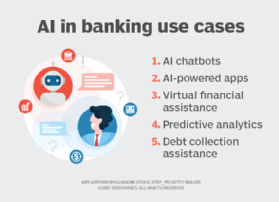AI use cases in banking create opportunities, improve systems
AI has become increasingly more common in the banking industry and has found a home sifting through data, improving back-end systems and assisting with customer service.
While the banking industry has prospered for hundreds of years, there are still processes and procedures that can benefit from improved AI technology.
Demands on banks have skyrocketed, and AI has given these institutions opportunities to adapt. AI can identify patterns, spot anomalies and handle data at a much faster rate than humans, bolstering use cases for AI in banking.
Enhancing the customer banking experience
AI-powered experiences, such as chatbots, are having a positive impact on consumer relationships. These bots can proactively start conversations with customers, provide relevant information and help answer customer questions after banking hours.
Wells Fargo launched a chatbot utilized by banking customers and bank employees to help with various customer service requests. The bot can handle questions relating to account information, specific transactions and general topics, such as locations for the nearest ATMs -- all without having to wait for a human to respond to a question.
This article is part of
What is enterprise AI? A complete guide for businesses
Another financial institution, Chase Bank, created an app for customers that enables them to interact with less friction. Powered by facial recognition technology, the app securely enables users to plan their expenses, ask questions, get help or deposit checks. The app is also capable of automatically completing transactions and sending out reminders to customers.
Reducing labor-heavy banking processes
While the banking industry is increasingly digital, it still has a surprising amount of human-based and paperwork-heavy processes. In these processes, banks face significant operational costs and risk issues stemming from human error. As a result, banks are applying AI to reduce or eliminate much of this time-intensive and error-prone work.

JPMorgan uses AI to enhance many internal processes. Multiple bots are used by its IT team to carry out tasks that normally would require a team of people. It has seen value in having AI facilitate changes to employee passwords. Through machine learning, conversational technology, process automation and other aspects of AI, these bots are able to interact with users using natural language to help reset passwords, often without requiring human assistance to complete the task. For a large organization such as JPMorgan, this could quickly add up to hundreds of hours of cost savings throughout a year.
Another early pioneer of using AI for banking, Bank of America, created Erica. Erica is a virtual financial assistant that helps users with a variety of banking-related activities, such as applying for credit cards, sending and receiving money, and helping with everyday banking tasks. The bot is touted as being able to make better decisions when it comes to lending than its human counterparts.
Additionally, mitigating risk is a top priority for banks as it can save money and reduce liability. Improved handwriting recognition, natural language processing and other technologies, combined with intelligent process automation tools, are being applied to back-office operations to handle a wide range of banking workflows.
At Citibank, teams are using AI to automate documentation tasks related to legal, compliance and risk. Predictive analytics and forecasting tools are also making their way into banks. Citibank is currently using AI to track changes to the markets utilizing data points in order to determine risks, workforce needs and other aspects of future planning.
Banks are also turning to AI to help with debt collection. Hanseatic Bank partnered with CollectAI in order to enhance its debt collection process. With the power of AI, it can identify not only the best time to contact debtors, but the best channels through which to reach them. Further, the AI can offer a good estimation of a debtor's likelihood of paying. According to CollectAI, after it implemented the partnership with Hanseatic, debt successfully collected went up by 14% in just six months.
The future of AI in banking
AI in banking is continuing to transform the industry to provide greater levels of value to customers, reduce risks and increase opportunities involved in being the financial engines of our modern economy.
However, it's important to keep humans in the loop. Some of these systems are making important decisions regarding loan applications, approving or denying credit card transactions or debt collection, and they need oversight by humans to ensure they are running as expected.
The possibilities for AI in the banking world are promising, and we expect to see more applications of AI and many more banks adopt AI over the next few years.







